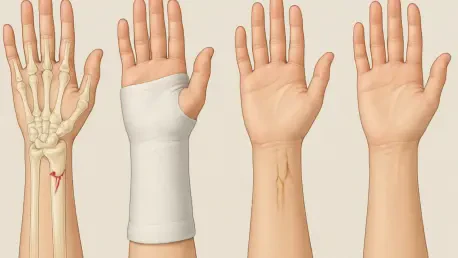Wrist fractures, specifically distal radius fractures, rank among the most frequent orthopedic injuries, particularly impacting older adults who are prone to falls or trauma. These injuries often disrupt daily routines with persistent pain and limited mobility, making recovery a frustratingly slow process for many. For those affected, traditional treatments like casting or splinting, while effective for realigning the bone, can lead to complications such as stiffness and swelling that delay full healing. The search for innovative methods to accelerate recovery and restore function has become a pressing concern in orthopedic care. One emerging approach, known as Fu’s Subcutaneous Needling (FSN), offers a potential breakthrough by combining a specialized acupuncture technique with conventional rehabilitation exercises. This method targets tissue near the injury to possibly enhance blood flow and reduce inflammation, sparking curiosity about its effectiveness. Exploring whether FSN could transform the recovery process for wrist fracture patients reveals a promising intersection of traditional practices and modern medical needs, prompting a deeper look into its application and the evidence behind it.
Understanding the Challenge of Wrist Fractures
Distal radius fractures, occurring at the end of the forearm bone near the wrist, present a significant hurdle due to their prevalence and the functional limitations they impose. Often resulting from a fall on an outstretched hand, these fractures are especially common among older adults with reduced bone density, leading to intense discomfort and restricted hand movement. The standard approach of closed reduction followed by immobilization in a cast or splint aims to stabilize the bone for proper alignment. However, this necessary step frequently introduces setbacks, as prolonged lack of movement can cause joint stiffness, muscle atrophy, and persistent swelling, all of which hinder a patient’s ability to return to normal activities. These complications underscore the critical need for strategies that not only heal the bone but also preserve surrounding tissue health during recovery.
Beyond the physical challenges, the rehabilitation phase after immobilization often proves inconsistent across patients. Many struggle with adhering to prescribed exercise regimens, while others face delays in regaining strength due to non-standardized protocols in post-fracture care. This variability can extend recovery timelines and diminish quality of life, as simple tasks like gripping or lifting remain out of reach for weeks or even months. The limitations of conventional treatment have fueled interest in adjunctive therapies that might address these gaps, offering hope for a more efficient healing process. As research continues to evolve, the focus has shifted toward finding complementary methods that can mitigate the adverse effects of immobilization while supporting comprehensive recovery for wrist fracture sufferers.
Exploring Fu’s Subcutaneous Needling as a Solution
Fu’s Subcutaneous Needling (FSN), a technique pioneered by Dr. Zhong-Hua Fu, stands out as an innovative adaptation of acupuncture principles tailored for modern therapeutic needs. Unlike traditional acupuncture, which often penetrates deeper into muscle layers, FSN involves inserting a specialized needle just beneath the skin’s surface near the injured area, followed by a gentle swaying motion to stimulate the subcutaneous tissue. This method is designed to enhance local blood circulation, reduce inflammation, and alleviate pain without invasive measures, presenting a low-risk option for patients. The unique approach of FSN aims to trigger the body’s natural healing mechanisms, making it a compelling candidate for supporting recovery in musculoskeletal conditions such as wrist fractures.
Initial studies on FSN have shown encouraging results, suggesting it could play a valuable role in managing post-injury symptoms like swelling and restricted mobility. By focusing on the tissue surrounding the fracture site, this technique may help counteract some of the negative effects of prolonged immobilization, such as stiffness that often lingers after a cast is removed. Its non-invasive nature also makes it an attractive addition to standard care, potentially reducing reliance on medications that carry risks of side effects. As interest in integrative medicine grows, FSN represents a bridge between traditional Eastern practices and contemporary orthopedic challenges, prompting further investigation into how it might enhance outcomes for those recovering from distal radius fractures.
Potential Benefits of FSN in Fracture Healing
The appeal of Fu’s Subcutaneous Needling lies in its potential to directly address the common complications associated with wrist fracture recovery. By stimulating the subcutaneous tissue near the wrist, FSN may improve blood flow to the area, which is essential for delivering nutrients and oxygen that support bone and soft tissue repair. This enhanced circulation could lead to a reduction in inflammation and swelling, two persistent issues that often slow down the healing process after immobilization. For patients, this might translate to less discomfort during the early stages of rehabilitation, allowing them to engage more effectively in exercises designed to restore strength and flexibility.
Another promising aspect of FSN is its capacity to promote joint mobility sooner in the recovery timeline. After weeks in a cast, the wrist often becomes rigid, making even basic movements painful or difficult. The gentle stimulation provided by FSN could help loosen tight tissues and ease pain, enabling patients to progress through rehab with greater ease and confidence. When combined with structured physical therapy, this technique might serve as a critical link between the static phase of casting and the active phase of functional restoration, potentially shortening the overall recovery period. If validated through rigorous studies, such benefits could position FSN as a key component in modern fracture care protocols, offering a holistic approach to overcoming the hurdles of healing.
Clinical Research on FSN Effectiveness
To determine the true impact of Fu’s Subcutaneous Needling on wrist fracture recovery, a structured clinical trial has been designed to evaluate its efficacy under controlled conditions. This study divides participants with distal radius fractures into two groups: one receiving authentic FSN treatments alongside standard rehabilitation exercises, and the other undergoing a sham procedure that mimics FSN without actual needle insertion, paired with the same rehab program. This sham-controlled setup is crucial for isolating the specific effects of FSN, ensuring that observed outcomes are not merely due to placebo responses or the benefits of exercise alone. By maintaining strict randomization and blinding of participants, the trial seeks to deliver unbiased insights into whether this technique can genuinely enhance healing.
The research focuses on multiple outcomes to provide a comprehensive assessment of FSN’s potential. The primary measure is the time required for radiographic union, which indicates bone healing through X-ray evidence of callus formation and cortical bridging. Secondary outcomes include patient-centered metrics such as pain levels, swelling, and functional recovery, often assessed using standardized tools like the Disabilities of the Arm, Shoulder, and Hand (DASH) score. Additionally, the study tracks anatomical alignment post-healing to ensure the fracture site maintains proper structure. With a detailed treatment schedule—starting with frequent sessions in the first week post-reduction and tapering over eight weeks—this trial aims to build a robust evidence base that could influence how wrist fractures are managed in clinical practice.
Implications for Patients and Healthcare
If Fu’s Subcutaneous Needling demonstrates effectiveness in speeding up wrist fracture recovery, the implications for patients could be transformative. A faster healing process might mean shorter periods of pain and restricted movement, allowing individuals to return to daily tasks like writing, typing, or lifting with less delay. This could significantly improve quality of life, especially for older adults who often face greater challenges in regaining full function after such injuries. Moreover, a non-invasive option like FSN could reduce the need for prolonged medication use, minimizing potential side effects and offering a more natural path to recovery that aligns with growing patient preferences for holistic care approaches.
For healthcare providers, the successful integration of FSN into treatment protocols could redefine standard care for distal radius fractures, particularly in regions where acupuncture-based therapies are culturally accepted and accessible. This method might become a cost-effective addition to rehabilitation plans, easing the burden on medical systems by potentially reducing recovery times and associated complications. Furthermore, positive results from ongoing research could spur additional studies into other acupuncture techniques for various musculoskeletal conditions, broadening the scope of integrative medicine. As the medical field increasingly embraces multimodal strategies, FSN stands to contribute to a future where traditional and modern practices work hand-in-hand to optimize patient outcomes.
Looking Ahead at Recovery Innovations
Reflecting on the exploration of Fu’s Subcutaneous Needling, it becomes evident that past efforts to manage wrist fractures through immobilization alone often fell short in addressing long-term functional challenges. The complications of stiffness and delayed healing have long frustrated both patients and clinicians, highlighting a gap that demands innovative solutions. The introduction of FSN in clinical trials marks a pivotal moment, as it brings a fresh perspective to combining non-invasive techniques with established rehabilitation practices, aiming to enhance the healing journey for countless individuals who have struggled with recovery.
Moving forward, the focus should shift to actionable steps that build on these research efforts. Healthcare systems could prioritize training practitioners in FSN techniques to ensure consistent application if trial results prove favorable. Additionally, expanding access to such therapies in diverse settings might address disparities in recovery outcomes across populations. Future considerations should also include adapting FSN protocols for other fracture types or injury contexts, potentially unlocking broader applications. By fostering collaboration between orthopedic specialists and integrative medicine experts, the field can continue to evolve, ensuring that patients benefit from cutting-edge advancements tailored to their unique needs in overcoming the aftermath of wrist fractures.









